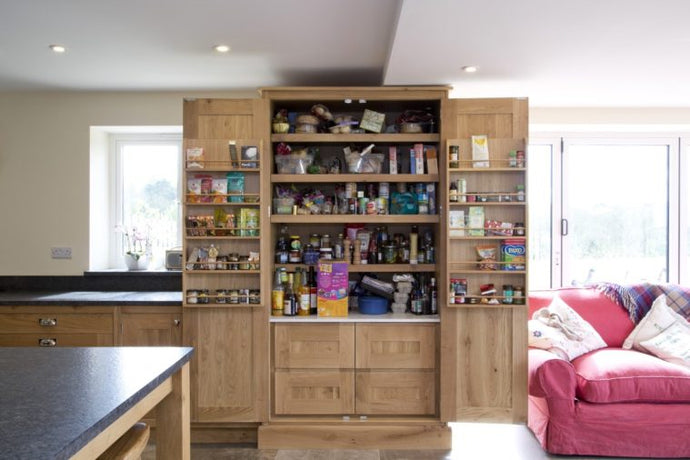- No products in the cart.
TRADITIONAL VS. MODERN LARDERS: A COMPREHENSIVE COMPARISON
24
Sep
The kitchen is often considered the heart of the home, and an essential part of a functional kitchen is efficient storage. Larders, historically known as a room or large cupboard for storing food, have evolved over time to suit the needs and trends of modern living. In this comprehensive comparison, we will explore the differences and similarities between traditional larders and their modern counterparts. Understanding the features, advantages, and drawbacks of both styles will assist homeowners in making informed decisions when planning or renovating their kitchens.
- Traditional Larders
- Historical Context
- Origins of Larders: Larders have been part of home design for centuries, initially used to store perishable food items and preserve them in a cool, dark space.
- Evolution over Time: Traditional larders were standalone rooms, often with stone or thick walls to maintain a consistent temperature. They were equipped with shelves, hooks, and storage bins for food preservation.
- Design and Structure
- Materials Used: Traditional larders were primarily constructed with wood, stone, or brick, providing a sense of durability and stability.
- Spaciousness: Being separate rooms, traditional larders had ample space for storing large quantities of food and beverages.
- Cooling Mechanism: Traditional larders relied on natural cooling and ventilation due to their location and design, keeping perishables fresh.
- Advantages of Traditional Larders
- Ample Storage Space: Traditional larders offer vast storage capacities, allowing homeowners to store a variety of food items and kitchen essentials.
- Effective Preservation: The design and location of traditional larders provided effective preservation, extending the shelf life of perishable items.
- Authenticity and Character: Traditional larders add a touch of historical authenticity and character to homes, appealing to those who appreciate traditional architecture and design.
- Modern Larders
- Contemporary Design Trends
- Integration with Kitchen Space: Modern larders are typically integrated into the kitchen layout, resembling large cupboards or built-in pantry units.
- Focus on Aesthetics: Modern larders emphasize aesthetics, often designed to match the overall style of the kitchen and offer a seamless appearance.
- Technological Integration: Modern larders may incorporate technology such as temperature control, lighting, and automated features for a more convenient user experience.
- Design and Structure
- Materials Used: Modern larders often feature materials like stainless steel, glass, or sleek wood finishes, providing a contemporary and minimalist look.
- Compact and Space-Saving: Modern larders are designed to maximize storage in smaller spaces, making them ideal for apartments or modern homes with limited square footage.
- Customization and Organization: Modern larders offer various customizable storage options, including pull-out drawers, adjustable shelves, and specialized compartments for organized storage.
- Advantages of Modern Larders
- Space Efficiency: Modern larders are optimized for smaller spaces, providing efficient storage solutions while maintaining a sleek and compact design.
- Enhanced Accessibility: Modern larders are designed for easy access to items, incorporating features like pull-out shelves and clear glass doors for better visibility.
- Integration with Modern Living: Modern larders align with the lifestyle and design preferences of contemporary homeowners, offering a blend of functionality and style.
III. Comparison and Contrast
- Storage Capacity and Flexibility
- Traditional Larders: Offer vast storage capacity, suitable for large households or those requiring extensive storage. The fixed shelves and ample space cater to bulk storage needs.
- Modern Larders: Prioritize flexibility and organization, allowing users to customize storage according to their needs. Adjustable shelves and compartments accommodate various items efficiently.
- Aesthetics and Design
- Traditional Larders: Convey a vintage, rustic charm, contributing to a timeless and classic aesthetic in traditional or historically themed homes.
- Modern Larders: Reflect contemporary design elements, providing a sleek, minimalist appearance that seamlessly integrates with modern kitchen aesthetics.
- Energy Efficiency and Environmental Impact
- Traditional Larders: Tend to be more energy-efficient due to their natural cooling mechanisms, reducing reliance on electricity for cooling purposes.
- Modern Larders: May consume more energy, especially if equipped with temperature control features, potentially impacting the environment and utility bills.
- Cost Considerations
- Traditional Larders: Often more expensive to construct or renovate due to the materials used and the need for a separate, adequately insulated space.
- Modern Larders: Typically more cost-effective, especially in terms of installation and renovation, as they are integrated into the existing kitchen layout.
Practicality and Convenience
- Ease of Installation and Maintenance
- Traditional Larders: Installation and maintenance of traditional larders may require more time and effort due to their standalone structure. Regular maintenance includes inspecting for pests and ensuring proper ventilation.
- Modern Larders: Installation of modern larders is generally simpler and quicker, especially for built-in or modular units. Maintenance involves routine cleaning and organizing, ensuring it remains functional and appealing.
- Accessibility and User-Friendliness
- Traditional Larders: Although spacious, accessing items in traditional larders can be more labor-intensive, especially for items stored towards the back. Organization is essential for efficient use.
- Modern Larders: Modern larders often incorporate pull-out shelves, drawers, and smart organization systems, providing easier access and enhancing the overall user experience.
- Integration with Daily Life
- Traditional Larders: Traditional larders may feel somewhat disconnected from the rest of the living space due to their separate room design.
- Modern Larders: Modern larders, being integrated into the kitchen layout, seamlessly blend with daily cooking and dining activities, enhancing practicality.
- Adaptability to Lifestyle
- Modern Living Standards and Time Constraints
- Traditional Larders: With the fast-paced lifestyle of modern times, the traditional larder's extensive storage might not align with quick and easy access to everyday items.
- Modern Larders: The convenience and accessibility offered by modern larders suit contemporary, busy lifestyles, enabling efficient meal preparation and planning.
- Evolving Dietary Preferences and Storage Needs
- Traditional Larders: While spacious, traditional larders may not cater to specific dietary preferences, such as the need for specialized storage for dietary restrictions or health-focused ingredients.
- Modern Larders: The flexibility and customization options in modern larders allow for better accommodation of diverse dietary needs, enabling organized storage and access to a variety of food items.
VII. Future Trends and Sustainability
- Sustainable and Environmentally Friendly Options
- Traditional Larders: As the focus on sustainability grows, repurposing or renovating existing traditional larders becomes an eco-friendly option, promoting resource conservation.
- Modern Larders: With advancements in sustainable materials and energy-efficient designs, modern larders can be designed with eco-friendly principles, contributing to a greener living space.
- Technological Integration for Efficiency
- Traditional Larders: Integrating modern technology into traditional larders may be challenging due to their historical design, limiting options for energy-efficient upgrades.
- Modern Larders: Future trends may include further integration of smart technology, enhancing energy efficiency and offering advanced features for temperature control, inventory tracking, and more.
Showcasing Real-Life Examples
- Traditional Larder Case Study
- Historical Restoration: Explore a case study of a homeowner who decided to restore and repurpose an existing traditional larder in a historic home. Discuss the challenges, design choices, and how the larder was incorporated into the modern lifestyle while preserving its historical integrity.
- Country Farmhouse Larder: Present a case study showcasing a traditional larder in a country farmhouse, emphasizing its spaciousness, natural cooling properties, and how it complements the rustic design of the home.
- Modern Larder Case Study
- Urban Apartment Integration: Showcase a case study of a compact urban apartment where a modern larder was seamlessly integrated into the kitchen layout, maximizing storage in a limited space and enhancing the apartment's contemporary design.
- Smart Technology Integration: Highlight a case study where a homeowner incorporated smart technology into their modern larder, emphasizing the efficiency and convenience it brings to daily food management and storage.
- User Perspectives: Interviews and Testimonials
- Interview with Traditional Larder Enthusiast
- Homeowner Perspective: Conduct an interview with a homeowner who opted for a traditional larder, exploring their reasons, experiences, and tips for those considering a similar design choice.
- Interview with Modern Larder Advocate
- Homeowner Perspective: Conduct an interview with a homeowner who chose a modern larder, delving into their motivations, the advantages they've experienced, and advice for others contemplating a modern larder design.
- Future of Larders: Predictions and Innovations
- Technological Advancements
- Smart Larder Systems: Discuss the potential integration of AI and smart systems into larders, predicting features like automated inventory tracking, recipe suggestions based on available items, and energy-efficient cooling.
- Sustainable Innovations
- Eco-Friendly Materials: Predict the use of innovative, sustainable materials in larder construction, emphasizing how future larders may contribute to a more sustainable and environmentally conscious lifestyle.
XII. Making the Choice: Considerations and Decision Guide
- Decision-Making Factors
- Lifestyle and Space: Highlight the importance of evaluating lifestyle needs and available space when deciding between a traditional or modern larder.
- Budget and Investment: Discuss the budget considerations for both styles, emphasizing the long-term investment and value they can add to a home.
- Balancing Tradition and Modernity
- Hybrid Designs: Introduce the concept of combining traditional elements with modern functionality, showcasing how homeowners can create a unique larder that incorporates the best of both worlds.
XIII. Conclusion
In conclusion, the choice between a traditional and modern larder is a matter of personal preference and practicality. Both styles offer distinct advantages, and understanding these differences can help homeowners make an informed decision based on their needs, design preferences, and available space. As we progress into the future, larders will continue to evolve, integrating technology, sustainability, and personalized features to suit the ever-changing lifestyles of individuals and families. Ultimately, the goal is to create a functional and aesthetically pleasing storage solution that enhances the overall kitchen experience.














